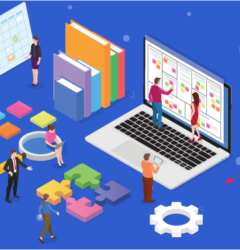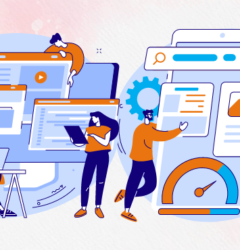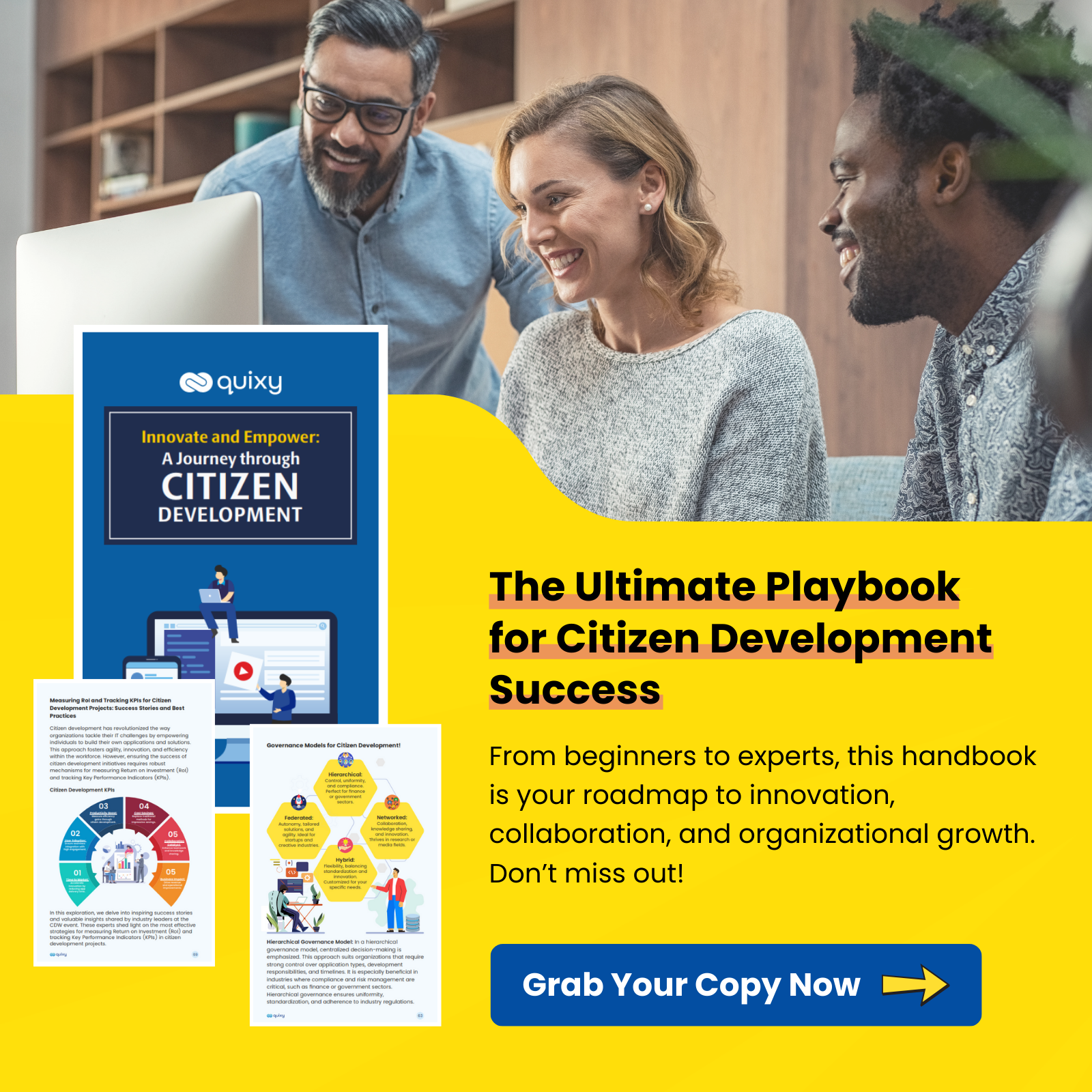
Are you looking to enhance your skills and significantly impact your organization without becoming a technical expert? If so, you might want to become a citizen developer! Citizen developers are non-technical professionals who leverage low-code or no-code platforms to create applications and automate processes, and they are becoming increasingly popular in organizations worldwide. With citizen development, you can boost your productivity, efficiency, and creativity while positively impacting your team and organization.
Who is a Citizen Developer?
A citizen developer is a non-technical professional who leverages low-code or no-code platforms to create applications and automate processes. Unlike traditional developers with deep technical expertise in programming languages and software development, citizen developers typically come from various departments and roles, such as sales, marketing, HR, and finance.
Citizen developers use intuitive visual interfaces and drag-and-drop features to build custom applications, workflows, and reports, without writing a single line of code. They rely on pre-built components, templates, and integrations to create applications quickly and easily. Citizen developers can help organizations to be more agile, responsive, and innovative by creating applications that meet the unique needs of their teams and departments. They are becoming increasingly popular in today’s digital economy, where speed, flexibility, and innovation are critical to success. You can also check out Citizen Developer’s Toolbox: Insights and Strategies from Our eBook-Innovate and Empower: A Journey through Citizen Development!
Also Read: A Guide to Suitability Assessment in Citizen Development
How Citizen Development Platforms are Changing the Game?
Citizen development platforms are revolutionizing how businesses approach application development and process automation. With these platforms, non-technical professionals can easily create applications and automate workflows, reducing the reliance on IT departments and allowing for faster turnaround times.
Citizen development platforms provide a simple, user-friendly interface that allows users to drag and drop pre-built components and configure them to create custom workflows and applications. Moreover, these platforms enable collaboration between different departments and teams, leading to more efficient and effective solutions. By democratizing the application development process, citizen development platforms are changing the game, allowing businesses to be more agile, responsive, and innovative.
Citizen Developers are Bridging the IT Gap
A citizen development program is an initiative that aims to promote and facilitate the development of applications and automation of processes by non-technical professionals. These programs provide training, resources, and support to enable employees from different departments and roles to become citizen developers. Citizen development programs typically involve:
- Selecting a suitable low-code or no-code platform.
- Providing access to data sources.
- Providing training and support to help employees learn how to use the platform effectively.
By implementing a citizen development program, organizations can empower their employees to drive innovation and productivity while reducing the burden on the IT department. Moreover, it can help organizations adapt to the rapidly changing technological landscape and remain competitive in their respective industries.
Also Read: Do you have what it takes to be a Citizen Developer?
Benefits of Citizen Development
Citizen development empowers non-technical users to create applications and automate processes, offering several key benefits:
- Faster Innovation: Enables rapid prototyping and deployment of solutions without waiting for IT teams.
- Cost Efficiency: Reduces reliance on expensive development resources by leveraging user-friendly tools.
- Increased Productivity: Automates repetitive tasks, freeing up time for more strategic work.
- Empowered Employees: Encourages creativity and problem-solving among non-technical staff.
- Agility: Allows organizations to quickly adapt to changing business needs with custom-built solutions.
- Reduced IT Backlog: Offloads simple app development tasks from IT teams, allowing them to focus on complex projects.
By democratizing app development, citizen development fosters innovation and operational efficiency across organizations.
Also Explore: How Low-Code Empowers Citizen Developers?
Why Should Companies Invest in Citizen Developers?
Investing in citizen developers offers significant advantages for organizations looking to stay competitive and agile in today’s fast-paced business environment. Here’s why companies should embrace and support citizen development:
- Accelerated Digital Transformation: Citizen developers enable faster creation of applications and automation of processes, helping companies adapt to digital trends more quickly.
- Cost Savings: By empowering non-technical employees to build solutions, companies reduce dependency on expensive external developers or overburdened IT teams.
- Increased Innovation: Citizen developers bring fresh perspectives and domain expertise, leading to creative solutions tailored to specific business needs.
- Improved Efficiency: Automating repetitive tasks and streamlining workflows through citizen-developed tools boosts overall productivity and operational efficiency.
- Enhanced Agility: Citizen developers can quickly respond to changing business requirements, allowing organizations to pivot faster in dynamic markets.
- Empowered Workforce: Providing employees with the tools to solve their own problems fosters a culture of ownership, engagement, and continuous improvement.
- Reduced IT Bottlenecks: Offloading simple development tasks to citizen developers frees up IT teams to focus on complex, high-priority projects.
- Scalability: Citizen development allows organizations to scale their digital capabilities without proportionally increasing IT resources.
- Competitive Advantage: Companies that leverage citizen developers can innovate faster, respond to customer needs more effectively, and stay ahead of competitors.
- Democratization of Technology: Citizen development democratizes access to technology, enabling employees at all levels to contribute to the organization’s digital growth.
By investing in citizen developers, companies not only optimize their resources but also foster a culture of innovation, collaboration, and adaptability, which are critical for long-term success.
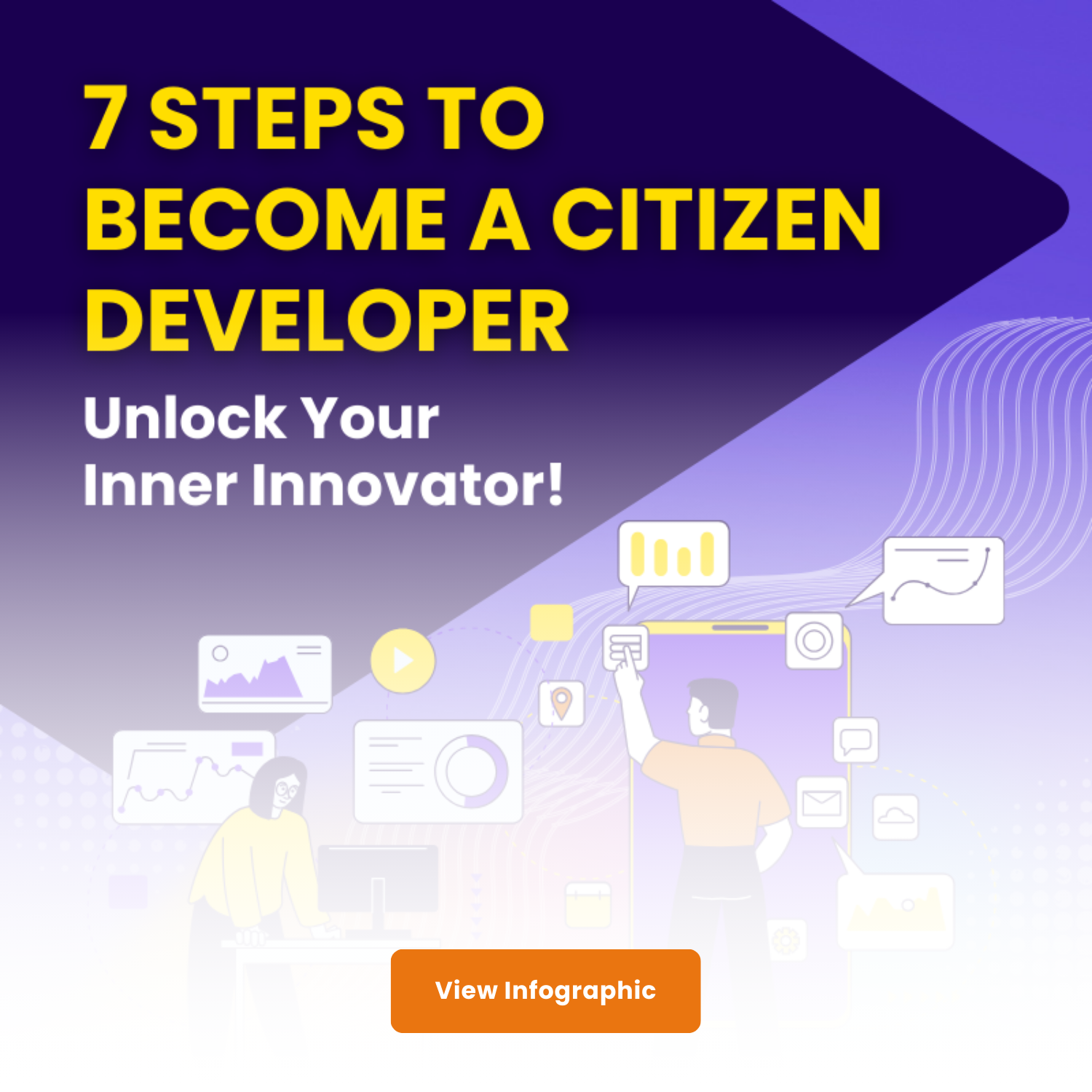
Characteristics of a Citizen Developer
To become a successful citizen developer, you need to master key skills that will allow you to build effective applications and automate workflows. These skills include:
1. Problem-solving
The ability to identify opportunities to improve processes, analyze business problems, gather requirements, and create functional specifications.
2. Creativity and design
The ability to develop user-friendly interfaces and visually appealing applications, create prototypes and wireframes, and test and refine them based on user feedback.
3. Data management and analysis
The ability to work with data sources, create reports that provide insights into business performance and apply data analysis techniques.
4. Communication and collaboration
The ability to communicate effectively with stakeholders, understand their needs and collaborate with team members to build applications that meet the unique needs of their departments.
5. Learning and adaptability
The willingness to learn and keep up with technological trends, stay up-to-date with the latest tools and techniques, and adapt to changing business needs.
6. Systematic Approach
Viewing products as holistic systems helps identify and solve problems comprehensively, ensuring effective solutions.
7. Eye for Design
Creating clean and visually appealing designs enhances user experience and navigation, optimizing the potential of no-code customization.
8. Data Skills
Proficiency in data collection and analysis empowers informed decision-making, facilitating product improvement and optimization.
9. Patience
Resilience in troubleshooting no-code tools’ challenges helps build high-quality products that meet users’ needs.
10. Project Management Skills
Efficiently planning and executing projects enhances product delivery within defined timelines and budgets.
11. User Empathy
Understanding users’ needs and pain points fosters the creation of valuable products that genuinely resonate with their experiences.
By developing these key skills, you can unlock your inner citizen developer and create innovative solutions that transform your organization. Citizen development platforms provide the tools and resources to support your learning and development, so you can quickly become proficient in creating applications and automating workflows.
Also Read: Workflow Automation Use Case Ideas to 10X your Productivity at Work
How to Become a Citizen Developer in 7 easy steps
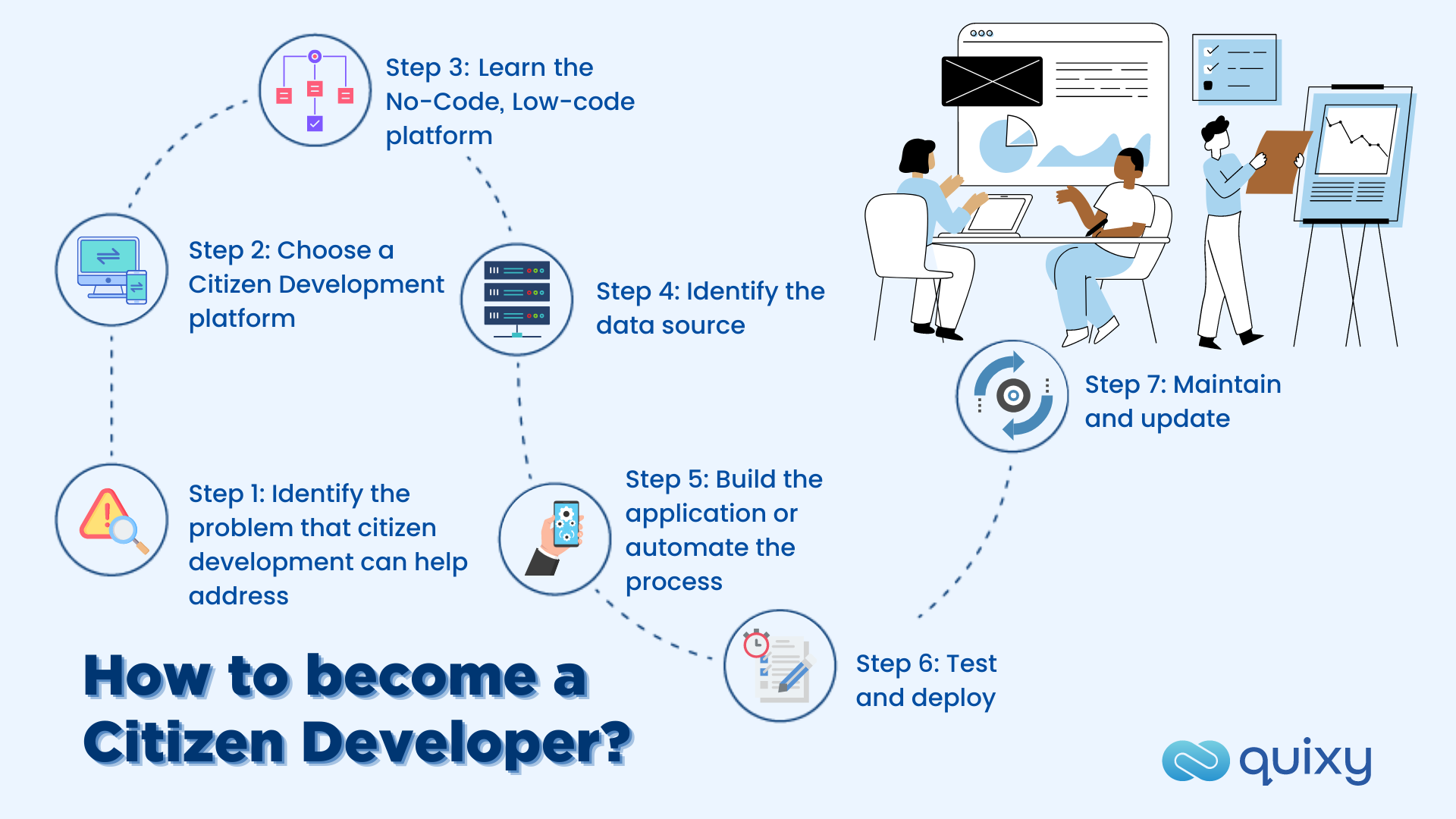
Let us guide you through seven simple steps to become a citizen developer, so you can take advantage of this exciting and rewarding opportunity.
Step 1: Identify the problem or opportunity that Citizen Development can help address
The first step to becoming a citizen developer is to identify the need. You should ask yourself, what problem do I need to solve or what process do I need to automate? Once you have identified the need, you should evaluate whether it fits a low-code or no-code platform. Low-code platforms are ideal for applications that have moderate complexity, while no-code platforms are more suitable for simple applications or automating simple processes.
Step 2: Choose a Citizen Development platform
Once you have identified the need, the next step is to choose a platform. There are many low-code and no-code platforms available in the market. Some popular platforms are PowerApps, Quixy, Appian, Mendix, and Salesforce. Each platform has its strengths and weaknesses, and you should evaluate which one best fits your needs. You should consider factors like ease of use, features, integrations, and pricing.
Step 3: Learn the low-code no-code development platform
After selecting a platform, the next step is to learn how to use it. The good news is that most low-code and no-code platforms are designed to be user-friendly and require little to no coding experience. You can learn the platform through online tutorials, training courses, or by joining user groups. You should start with the basics of citizen development and gradually build your skills as you become more familiar with the platform.
Step 4: Identify the data source
Before you start building your application or automating your process, you need to identify the data source. The data source is where the data that you need to use in your application or process is stored. It could be a database, a spreadsheet, or a web service. You need to ensure that you have access to the data source and understand the data structure.
For instance, if you want to build an application that tracks customer orders, you need to identify the data source that contains information about the customers and their orders. The data source could be a database where customer data is stored, an Excel spreadsheet that contains order information, or a web service that provides real-time data about customer orders.
Once you have identified the data source, you need to ensure that you have the necessary permissions to access it. You also need to understand the data structure, such as the fields and data types used in the data source. This understanding will help you design and develop your application or process in a way that uses the data effectively and efficiently.
Step 5: Build the application or automate the process
Once you have identified the need, selected a platform, learned how to use it, and identified the data source, you are ready to build your application or automate your process. This is the most exciting part of becoming a citizen developer. You can start building your application or process using drag-and-drop tools, templates, or customizing existing apps. You can also use pre-built connectors to integrate with other systems.
Step 6: Test and deploy
After building your application or process, the next step is to test it. You should ensure that it meets the requirements and functions as expected. You can test the application using test data or running it in a sandbox environment. Once you are satisfied that it works correctly, you can deploy it to production. Deployment involves publishing your application or process to the intended users.
Step 7: Maintain and update
The final step is to maintain and update your application or process. You should monitor it to ensure it continues functioning correctly and that any issues are promptly addressed. You should also update it to incorporate new features, improve performance, or address security concerns. Maintenance and updates are essential to ensure your application or process remains relevant and effective.
Also Read: Citizen Developer VS Professional Developer

Citizen Developers VS Professional Developers: Collaborating for Success
Citizen developers and professional developers are two distinct groups of individuals with different backgrounds, skill sets, and goals. Professional developers typically have extensive training and experience in computer science, programming languages, and software development methodologies. They are responsible for designing, building, testing, and maintaining complex software applications that meet the needs of their clients or organizations.
On the other hand, citizen developers are non-technical professionals who use low-code or no-code platforms to build custom applications and automate workflows to meet their business needs. They may have a basic understanding of programming concepts, but they do not have the same expertise as professional developers. Citizen developers typically create applications specific to their department or team rather than building complex systems across the organization.
While there are differences between these two groups, both can play important roles in driving digital transformation and innovation in organizations. Professional developers bring expertise and experience to complex software development projects. In contrast, citizen developers can leverage their deep knowledge of their business processes to create custom applications that meet their specific needs quickly and efficiently. Ultimately, a mix of both citizen developers and professional developers can help organizations to be more agile, responsive, and innovative in today’s fast-paced business environment.
Also Read: Meet the Top Citizen Development Influencers
Citizen Development Framework: A Guide to Building Productive Applications
A citizen development framework is a set of guidelines and best practices that organizations can follow to empower non-technical employees to create applications and automate workflows. The framework provides a structured approach for citizen developers to follow, which helps ensure that applications are secure, scalable, and compliant with the organization’s policies and regulations. With the citizen development value tree by your side, budgeting transforms into a value-driven art, making every investment count. A typical citizen development framework consists of the following elements:
1. Governance
A set of policies and guidelines that define the roles and responsibilities of citizen developers, establish standards for application development, and ensure that applications are aligned with the organization’s goals and strategies.
2. Training and support
A comprehensive training program that provides citizen developers with the skills and knowledge they need to build effective applications and automate workflows. The framework also includes ongoing support and guidance to help citizen developers troubleshoot issues and optimize their applications.
3. Collaboration and communication
A set of tools and processes that enable citizen developers to collaborate with other teams and stakeholders, share knowledge and best practices, and communicate effectively throughout the application development process.
4. Security and compliance
A set of guidelines and best practices that ensure that applications are secure, comply with relevant regulations, and protect sensitive data.
5. Metrics and feedback
A set of metrics and feedback mechanisms that enable organizations to track the success of citizen development initiatives, measure the impact of applications on business outcomes, and continuously improve the framework over time.
By following a citizen development framework, organizations can leverage the skills and creativity of their non-technical employees to create applications and automate workflows while ensuring that applications are secure, compliant, and aligned with the organization’s goals and strategies.
Also Read: Implement and Govern Citizen Development in your Organization
Tools and Platforms for Citizen Developers
Citizen development tools enable non-technical professionals to build applications and automate workflows quickly and easily. These platforms provide intuitive visual interfaces, drag-and-drop functionality, and pre-built components, templates, and integrations, so citizen developers can focus on the business logic and functionality of the application rather than the technical details of coding. Some popular citizen development tools include:
1. Quixy
Quixy provides a fast and efficient way to create sophisticated applications that meet the unique needs of businesses across various industries. Its ability to streamline workflows and automate processes makes it a standout tool for driving digital transformation and improving efficiency in organizations of all sizes.
2. Microsoft Power Apps
A low-code platform that allows users to build custom business applications using drag-and-drop interfaces and pre-built templates.
3. Google App Maker
A no-code platform that enables users to create custom applications and workflows for G Suite using a visual editor.
4. Quick Base
A low-code platform that enables users to build custom applications and workflows for their business needs using pre-built templates and integrations.
5. Salesforce Lightning
A low-code platform that allows users to build custom applications and automate workflows using a drag-and-drop interface and pre-built components.
These citizen development tools offer an easy-to-use platform for non-technical professionals to build custom applications and automate workflows quickly and efficiently without extensive programming knowledge or expertise. Using these tools, citizen developers can help organizations be more agile, responsive, and innovative by creating applications that meet the unique needs of their teams and departments.
Also Explore: Do you have what it takes to be a Citizen Developer?
Best Practices for Citizen Developers
Citizen developers play a vital role in driving innovation and efficiency within organizations. To ensure success and minimize risks, here are some best practices for citizen developers to follow:
| Best Practice | Key Actions |
|---|---|
| 1. Understand the Problem Before Building | – Define Clear Objectives: Clearly outline the problem and goals of your solution. – Engage Stakeholders: Collaborate with end-users to ensure the solution meets their needs. |
| 2. Start Small and Iterate | – Build MVPs (Minimum Viable Products): Start simple and refine based on feedback. – Test Frequently: Continuously test to identify and fix issues early. |
| 3. Leverage Low-Code/No-Code Platforms | – Choose the Right Tool: Select platforms that match your skill level and project complexity. – Use Pre-Built Templates: Speed up development with templates and drag-and-drop features. |
| 4. Follow Governance and Compliance | – Adhere to IT Policies: Ensure compliance with IT standards, security protocols, and data privacy regulations. – Seek Approval: Collaborate with IT teams to review and approve projects before deployment. |
| 5. Prioritize Security | – Protect Sensitive Data: Avoid handling sensitive data unless absolutely necessary and approved. – Use Secure Integrations: Ensure third-party tools or APIs are secure and reliable. |
| 6. Collaborate with IT Teams | – Maintain Open Communication: Work closely with IT to ensure alignment and avoid duplication. – Leverage IT Expertise: Seek guidance for complex tasks or scaling solutions. |
| 7. Document Your Work | – Keep Records: Document workflows, integrations, and decision points. – Share Knowledge: Make documentation accessible to promote collaboration and reuse. |
| 8. Focus on User Experience | – Design for Usability: Ensure the solution is intuitive and easy to use. – Gather Feedback: Continuously collect user feedback to improve functionality. |
| 9. Monitor and Maintain Solutions | – Track Performance: Regularly monitor to ensure the solution functions as intended. – Update Regularly: Make updates and improvements to keep the solution relevant. |
| 10. Upskill Continuously | – Learn New Tools: Stay updated on the latest low-code/no-code platforms and features. – Attend Training: Participate in workshops, webinars, or online courses to enhance skills. |
| 11. Avoid Overcomplicating Solutions | – Keep It Simple: Focus on solving the immediate problem without unnecessary complexity. – Reuse Existing Tools: Leverage existing systems and tools instead of building from scratch. |
| 12. Measure Success | – Set KPIs: Define key performance indicators (KPIs) to measure the impact of your solution. – Analyze Results: Use data to evaluate effectiveness and identify areas for improvement. |
By following these best practices, citizen developers can create effective, secure, and scalable solutions that deliver value to their organizations while minimizing risks and ensuring alignment with broader business goals.
Also Read: AI in the Citizen Developer Movement
Conclusion
Becoming a citizen developer is an empowering way to enhance productivity, efficiency, and creativity in today’s digital world. Following the seven steps outlined, you can become a valuable asset to your organization and drive positive change through technology. Remember, you don’t need a technical expert to be a citizen developer. With the right platform, tools, and mindset, anyone can create applications and automate processes that can make a significant impact. So, go ahead and take the leap into citizen development – you might be surprised at what you can achieve!
Frequently Asked Questions (FAQs)
What are the required 10 skills for a Citizen Developer?
Citizen development is all about empowering individuals to create solutions to their own problems using low-code or no-code tools. While technical skills are important, becoming a successful Citizen Developer requires a range of skills beyond coding. Here are some of the essential skills you need to become a Citizen Developer:
Be Patient: Citizen developers need patience as mastering no-code platforms takes time.
System Thinking: Citizen developers must view systems as a whole to understand relationships between parts.
Designing skills: Creating logical, user-friendly app interfaces is important for citizen developers.
Data Skills: Understanding data basics like structure, collection, and analysis are useful for no-code tools.
Problem-solving: Citizen Developers should have a strong problem-solving ability to identify, analyze and solve problems.
Creativity: Citizen Developers should be able to think creatively & come up with innovative solutions to solve problems.
Communication: Citizen Developers should have strong communication skills to communicate effectively with stakeholders, users, and team members.
Technical proficiency: Citizen Developers should have a basic understanding of programming concepts such as variables, functions, and logic can be helpful.
Analytical thinking: Citizen Developers should be able to analyze data, processes, and workflows to identify areas for improvement.
Adaptability: Citizen Developers should be able to adapt to changing technologies, processes, and workflows to stay updated and relevant.
How do I choose the right low-code or no-code platform?
When choosing a low-code or no-code platform, consider factors like ease of use, security, scalability, and compatibility with existing systems.
What are the benefits of becoming a citizen developer?
The benefits of becoming a citizen developer include creating customized software applications that meet specific business needs, increased productivity and efficiency, and improved decision-making capabilities.
Do I need any technical skills to become a citizen developer?
No, you don’t need any technical skills to become a citizen developer. Low-code and no-code platforms are designed to be user-friendly & intuitive, making it easy for anyone to create applications.
How can I continue to improve my citizen development skills?
To continue improving your citizen development skills, consider taking online courses or attending workshops on low-code and no-code platforms, joining online communities or forums dedicated to citizen development, and practicing your skills by building and testing new applications.
Subscribe
Login
Please login to comment
0 Comments
Oldest
